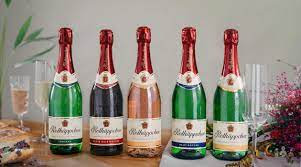



The closest thing we have this in the USA would be "country fried steak", which is also called "chicken fried steak" which is pork (not chicken) coated in breadcrumbs and fried. It is usually served with a white country gravy. It is very popular in the south and it's believed to have been brought to America by German immigrants.
 Due to the often limited availability of goods, people had to get creative in the east. Instead of using pork or veal, Jagdwurst sausage (think of baloney or Mortadella) was used. It's a cooked sausage made of pork that is seasoned with salt, green peppercorns, ginger and coriander. It can be eaten cold or hot and is often used in soups. Instead of the mushroom sauce and potatoes as in the west, Jägerschnitzel in the east was served with tomato sauce and spiral noodles. Below is a recipe for Jägerschnitzel that I found online from the DDR Museum.
Due to the often limited availability of goods, people had to get creative in the east. Instead of using pork or veal, Jagdwurst sausage (think of baloney or Mortadella) was used. It's a cooked sausage made of pork that is seasoned with salt, green peppercorns, ginger and coriander. It can be eaten cold or hot and is often used in soups. Instead of the mushroom sauce and potatoes as in the west, Jägerschnitzel in the east was served with tomato sauce and spiral noodles. Below is a recipe for Jägerschnitzel that I found online from the DDR Museum.

Ostalgie is a real thing. When the Berlin Wall came down people wanted western products. Also most of the eastern products were produced in outdated factories and the communist ideal that everyone had a job wasn't exactly compatible with capitalism so many factories in the east simply shut down especially as well-trained people quickly moved west in search of better opportunities and higher salaries.
 There are a few Ossi brands that did survive the fall of communism including, thank goodness, my favourite Spreewäldergurken, the world's absolute best pickles.
There are a few Ossi brands that did survive the fall of communism including, thank goodness, my favourite Spreewäldergurken, the world's absolute best pickles.

 Bautz'ner Senf is made in Bautzen, Saxony, and it was the most popular mustard in East Germany. It's still available and I often receive it my care packages from Claudia's mom. I actually use it as the base, along with honey, brown sugar and a bit of orange juice as the marinade for the ham I make every year for Thanksgiving.
Bautz'ner Senf is made in Bautzen, Saxony, and it was the most popular mustard in East Germany. It's still available and I often receive it my care packages from Claudia's mom. I actually use it as the base, along with honey, brown sugar and a bit of orange juice as the marinade for the ham I make every year for Thanksgiving.
Rotkäppchen is probably the most well-known brand to survive East German communism.
In 1856 some friends set up a wine store and the following year it became a sparkling wine factory. In 1894 they needed a new name so taking inspiration from the red crown cap, and from Little Red Riding Hood, Rotkäppchen sparkling wine came about.
In 1945, following the war, the company was nationalised and it was the market leader in the DDR days. Following German reunification, sales collapsed and the brand almost disappeared. In 1990 it became a limited liability company and the firm made the important decision to invest in new equipment. The company was privatised in 1993 and by 1995 it was the best selling sparkling wine in eastern Germany. By 2001 it was the best selling sparkling wine in all of Germany. I can even buy it in my little local Brněnka.
Here's a short, interesting video I found out on YouTube. I need to go check out this shop next time.
Here's the recipe for Hunter's Schnitzel with Tomato Sauce from the DDR Museum in Berlin.
Ingredients for the schnitzel:
- 8 slices of Jagdwurst (about finger-thick)
- 2 eggs
- some four
- some breadcrumbs
- oil, margarine or clarified butter for frying
- Flour both sides of each slice of Jagdwurst.
- Mix the eggs with the breadcrumbs and coat the slices of Jagdwurst with the mixture.
- Fry the slices in a pan with either oil, margarine, or clarified butter until they are golden brown.
- about 100g of tomato paste
- 200g of ketchup
- 1 onion
- 2 tablespoons of flour
- butter
- water
- salt and pepper
- Optional - sugar or vinegar
- Cut the onion into cubes and sauté in a pot with butter.
- Add tomato paste and flour and sauté while stirring continuously.
- Add water until a creamy consistency is obtained.
- Add ketchup and bring to a boil while continuously stirring.
- Simmer for about 10 minutes and season with salt and pepper.





























No comments:
Post a Comment